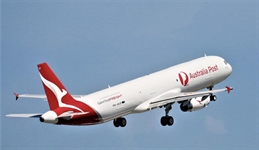
The Airbus A321 joined the ranks of freighter aircraft in service at the end of October at an auspicious time for all-cargo operators. With passenger traffic in the doldrums, freighters are going to account for the bulk of the global fleet growth in 2021, as conversion specialists are moving to ramp up their output.
On October 27, 2020, the world’s first A321 freighter was delivered by Vallair to Qantas. The airline has ordered altogether three A321 freighters and put the first into service for a venture with Australia Post.
Vallair was an early mover on the A321 freighter concept. Back in the spring of 2018 it signed agreements with 321 Precision Conversions and EFW to become the launch customer of both of their respective A321 conversion programs. At the time this seemed a bold step, as strong demand in the passenger business looked set to tie up A321s for a protracted period of time, leaving scarce – and expensive – feedstock for all-cargo conversions.
Today interest in A321 freighters is lively. In the space of barely a week, Vallair announced agreements with two customers to take altogether 12 A321 cargo planes.
321 Precision Conversions ‘first A321 freighter carried out its first test flight in early October. The company is a joint venture between conversion specialist Precision Aircraft Solutions and freighter leasing firm ATSG. Brian McCarthy, vice president aircraft trading at Precision Aircraft Solutions, said that the conversion specialist has been having talks with freighter operators as well as leasing firms and investors.
“We have significant interest in our program,” he said.
Although global airfreight volumes trail their tally from 2019, freighters are in hot demand, owing to the capacity shortage brought about by the drastic slump in the passenger business, which has decimated bellyhold capacity. According to Boeing, widebody belly capacity is down 58% year-on-year.
While passenger fleets imploded, the industry has added some 90 freighters to the global lineup this year. Freighter operators have also upped their utilization. Their operations have been 120% of last year’s level, Boeing found.
However, this has not been enough to compensate for the shortage of belly lift, a predicament that is now widely expected to last considerably longer than initially anticipated.
“We see the drag in belly lift in place for a few more years, remarked Darren Hulst, vice-president commercial marketing at Boeing.
McCarthy also expects heightened demand for freighter conversions, citing the growing realization that the recovery of the passenger business will take two or three years.
“We see more A321s moving to the ‘sales rack’,” he noted.
While the current belly shortage is a massive factor in the current situation, demand for freighters is expected to remain strong beyond the recovery of passenger operations from the Covid-19 setback. A major driver of demand is e-commerce, Hulst pointed out, adding that Cainiao has operated over 700 charter flights for deliveries outside China this year.
Network carriers also see benefits in maindeck capacity. Air Canada has decided to convert two planes of its grounded Boeing 767 fleet into cargo aircraft. The Canadian market does not support origin and destination traffic to justify international freighters, but as a supplement to a passenger fleet, feeding the network freighters can play a viable role, said Vito Cerone, managing director of cargo sales and commercial strategy.
One major arena where he sees promise is in flows between Asia and Latin America. Air Canada pursued this strategy a few years ago in a short-lived partnership with Cargojet, which operated freighters while Air Canada marketed the lift. Freighters serving several points in Latin America connected to the airline’s Asian traffic on its trans-Pacific flights.
Freighters will be critical for the air cargo industry in the coming years, Hulst said.
Boeing’s cargo forecast for the 2021-2040 period sees the global jet freighter fleet expand more than 60% from its current level to reach 3,260 units. Its analysts project 2,430 freighter deliveries during that time. Nearly half of that number – 1,080 aircraft – will be narrowbody planes, all of them converted passenger planes. Almost half of them will be used for express traffic, according to Boeing.
Conversion outfits are moving to ramp up their output. Boeing aims to turn 35 737s into freighters in 2021, up from 21 this year. It is also looking to add at least one conversion line for 767s.
Prior to adding the A321 to its programme, Precision Aircraft Solutions concentrated on 757 conversions. Demand for these has been lively, McCarthy reported. He expects to turn out converted 757s for a few more years yet.
Feedstock, which had been tight, is becoming readily available. American Airlines has retired its 757 fleet, and 19 out of those 24 aircraft are suitable for conversion, according to McCarthy. He estimated that there are altogether 150 757s left that could be turned into freighters.
As with the A321 and the 757, finding feedstock for 737-800 and 767 conversions was a struggle, but not any more, observed Tom Crabtree, regional director, Boeing Commercial Airplanes market analysis – air cargo.
By Ian Putzger
Air Freight Correspondent | Toronto




